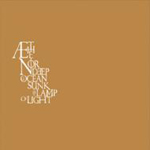|
|
 |
Dusted Reviews
Artist: Æthenor Album: Deep in Ocean Sunk the Lamp of Light Label: VHF Review date: Feb. 12, 2007 |

|
|
|
 |
Deep in Ocean Sunk the Lamp of Light is a sonic shadow box: images of sounds are arranged meticulously and set in motion, texture is palpable, and a convincing illusion of actual depth, even a sense of place, emerges – you are somewhere, but it’s impossible to say where. This powerful push and pull between the physical and the disembodied may derive from how the trio of Stephen O’Malley (of Sunn 0))) and Khanate), Daniel O’Sullivan (Guapo) and Vincent de Rougin (Shora) created the album’s four compositions, as they were culled and then later shaped from four late-night recording sessions in various cavernous spaces across Europe. The idea of space is so central to the record that each contributor is credited with playing - in addition to Fender Rhodes, piano, percussion, organ, Minimoog, guitar and contact microphones – “room”. This release is genuinely ambient and genuinely experimental, as the trio sidesteps any easy categorization one might foist on them based on their previous projects.
Two extended pieces and two shorter ones comprise a half-hour suite of atmospheres that refuse density and complexity, both hallmarks of the sounds the trio pursue on their own. The first section evokes a terrible isolation, its rhythm but not its sound being that of ocean swells: dead calm disturbed by momentary monoliths of bass tones, tinkling glass, the clank of metal and stray electronic textures. A creaking, reminiscent of the untethered sway of a ship’s mast, pans from channel to channel, making the piece’s rhythm a nauseating swing. Near the transition to the second section, chains get dragged across a concrete floor, but their sound is distant and almost unknowable, as is the grind of security gates and muffled howling that appears later.
Such recognizable percussion textures might have tempted the trio into making a lightweight horror flick soundtrack. Instead the textures give the music a realness that helps it surpass similar efforts. When the three begin to intertwine droning organ clusters, snippets of chiming melody from the Rhodes and static that encrusts like barnacles, these more abstract tones also gain realness. The experience stops being the usual linear one of music and becomes a tactile and unnerving one, as if your brain is turning this audio object around in your mental space, fingering its contours, ridges and hollows, and occasionally, getting lost in its depths.
By Matthew Wuethrich
|







